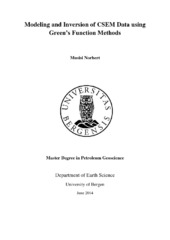| dc.description.abstract | The aim of the present study is to develop new approximations to the integral equation for 3D Controlled Source Electromagnetic (CSEM) synthetic data. Several scattering approximations to the integral equation have previously been developed to simulate the electromagnetic problems. In this thesis, new approaches to the approximate solution for the integral equation in 3D for marine CSEM at low frequency using the T-matrix approximation (TMA) and the Extended Born approximation (EBA) have been presented. Unlike the EBA that has been previously discussed in CSEM, the TMA has not yet been extended to CSEM though with many applications in seismics. The T-matrix approach only requires the knowledge of the perturbations and the Green's function to compute the electric field whereas the Extended Born approximation for electromagnetic forward modeling improves the ability to accurately simulate the internal fields for a distribution without inverting a large 3D matrix. The new methods have been implemented in MATLAB for forward modeling on synthetic marine CSEM data and the solutions compared with the Born approximation. In addition, sensitivity and validity of these methods for a reservoir in production with varying contrasts have been studied with several examples to show their accuracy. It appears that the new approximations have better accuracy and a wider electrical conductivity application range. The T-matrix is expected to approximate roughly the full integral equation solution for electromagnetic (EM) field, while the Extended Born is expected to improve the approaches of EM field over large conductivity contrasts between the reservoir and background model, compared to the Born approximation. The T-matrix and the Extended Born are valid for high contrasts. The effects of these approximations to different reservoir parameters have also been investigated. To improve the accuracy of these approximations, the number of grid blocks need to be increased at the expense of the computational cost. A cubic reservoir model works better than the rectangular block model for the T-matrix. Using numerical and analytical modeling, the T-matrix and the Extended Born have been expanded to CSEM monitoring of geophysical anomalies in the pore-fluid contents of the subsurface reservoirs. The ability of time-lapse CSEM data to monitor small changes in the electrical conductivity has been discussed. It has been found that these methods can detect the changes in the contrast of the reservoir due to fluid injection. | en_US |
